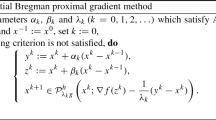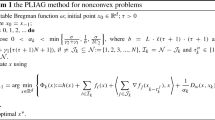Abstract
In this article, we study an important class of stochastic difference-of-convex (SDC) programming whose objective is given in the form of the sum of a continuously differentiable convex function, a simple convex function and a continuous concave function. Recently, a proximal stochastic variance reduction difference-of-convex algorithm (Prox-SVRDCA) (Xu et al., 2019) is developed for this problem. And, Prox-SVRDCA reduces to the proximal stochastic variance reduction gradient (Prox-SVRG) (Xiao and Zhang, 2014) as the continuous concave function is disappeared, and hence Prox-SVRDCA is potentially slow in practice. Inspired by recently proposed acceleration techniques, an accelerated proximal stochastic variance reduction difference-of-convex algorithm (AProx-SVRDCA) is proposed. Different from Prox-SVRDCA, an extrapolation acceleration step that involves the latest two iteration points is incorporated in AProx-SVRDCA. The experimental results show that, for a fairly general choice of the extrapolation parameter, the acceleration will be achieved for AProx-SVRDCA. Then, a rigorous theoretical analysis is presented. We first show that any accumulation point of the generated iteration sequences is a stationary point of the objective function. Furthermore, different from the traditional convergence analysis in the existing nonconvex stochastic optimizations, a global convergence property with respect to the generated sequences is established under the assumption: the Kurdyka-Łojasiewicz property together with the continuity and differentiability of the concave part in objective function. To the best of our knowledge, this is the first time that the acceleration trick is incorporated into nonconvex nonsmooth SDC programming. Finally, extended experimental results show the superiority of our proposed algorithm.




Similar content being viewed by others
References
Gasso G, Rakotomamonjy A, Canu S (2009) Recovering sparse signals with a certain family of nonconvex penalties and DC programming. IEEE Trans Signal Process. 57(12):4686–4698
Zhang S, Xin J (2014) Minimization of transformed \(l_1\) penalty: Theory, difference of convex function algorithm, and robust application in compressed sensing. Math Program. 169(3):1–30
Le Thi HA, Le HM, Pham Dinh T (2015) Feature selection in machine learning: an exact penalty approach using a difference of convex function algorithm. Mach Learn. 101(1–3):163–186
PhamDinh T, LeThi HA (1997) Convex analysis approach to DC programming: theory, algorithms and applications, Acta Math Vietnam 22 (1): 289–355
Wen B, Chen X, Pong T (2018) A proximal difference-of-convex algorithm with extrapolation. Comput Optimiz Appl 69(2):297–324
PhamDinh T, LeThi HA (1998) Optimization algorithm for solving the trust-region subproblem, SIAM J Optimiz 8 (2): 476–505
Ahn M, Pang J, Xin J (2017) Difference-of-convex learning: directional stationarity, optimality, and sparsity, SIAM J Optimiz 27 (3): 1637–1665
LeThi HA, PhamDinh T (2018) Dc programming and DCA: thirty years of developments, Math Program 169: 5–68
Pham DN (2016) DCA based algorithms for learning with sparsity in high dimensional setting and stochastical learning, Ph. D. thesis, University of Lorraine
Le Thi HA, Le HM, Phan DN, et al (2017) Stochastic DCA for sparse multiclass logistic regression. In: Advances in Intelligent Systems and Computing
Le Thi HA, Le HM, Phan DN, et al (2017) Stochastic DCA for the large-sum of non-convex functions problem and its application to group variable selection in classification. In: International Conference on Machine Learning
Le Thi HA, Huynh VN, Pham Dinh T (2019) Stochastic difference-of-convex algorithms for solving nonconvex optimization problems. arXiv:1911.04334v1
Nemirovski A, Juditsky A, Lan G et al (2009) Robust stochastic approximation approach to stochastic programming. SIAM J Optim 19(4):1574–1609
Roux N, Schmidt M, Bach F (2013) A stochastic gradient method with an exponential convergence rate for finite training sets. Adv Neural Inform Process Syst 4:2663–2671
Johnson R, Zhang T (2013) Accelerating stochastic gradient descent using predictive variance reduction. In: Advance in Neural Information Processing Systems, pp 315–323
Defazio A, Bach F, Julien S (2014) SAGA: a fast incremental gradient method with support for non-strongly convex composite objectives. AAdv Neural Inform Process Syst 2:1646–1654
Xiao L, Zhang T (2014) A proximal stochastic gradient method with progressive variance reduction. SIAM J Optimiz 24(4):2057–2075
Xu Y, Qi Q, Lin Q, et al (2019) Stochastic optimization for DC functions and non-smooth non-convex regularizers with non-asymptotic convergence. arXiv:1811.11829v2
Nguyen L, Liu J, Scheinberg K, et al (2017) Stochastic recursive gradient algorithm for nonconvex optimization. arXiv:1705.07261v1
Nguyen L, Scheinberg K, Taká M (2021) Inexact sarah algorithm for stochastic optimization. Optimiz Methods Softw 36(1):237–258
Lei L, Jordan M (2017) Less than a single pass: Stochastically controlled stochastic gradient. In: Proceedings of the 20th International Conference on Artificial Intelligence and Statistics, vol. 54, pp 148–156
Lu Q, Liao X, Li H, Huang T (2020) A computation-efficient decentralized algorithm for composite constrained optimization, IEEE Trans Signal Inform Process over Netw 6: 774–789
Lin Y, Jin X, Chen J et al (2019) An analytic computation-driven algorithm for decentralized multicore systems. Future Gene Comput Syst. 96:101–110
Sodhro AH, Pirbhulal S, de Albuquerque VHC (2019) Artificial intelligence-driven mechanism for edge computing-based industrial applications. IEEE Trans Ind Inform. 15(7):4235–4243
Beck A, Teboulle M (2009) A fast iterative shrinkage-thresholding algorithm for linear inverse problems.SIAM J Imaging Sci 2(1):183–202
Allen-Zhu Z (2017) Katyusha: The first direct acceleration of stochastic gradient methods. In: Acm Sigact Symposium on Theory of Computing
Zhou K (2018) Direct acceleration of SAGA using sampled negative momentum. arXiv:1806.11048v4
Nitanda A (2014) Stochastic proximal gradient descent with acceleration techniques. In: Advances in Neural Information Processing Systems
Allen-Zhu Z (2018) Katyusha X: Practical momentum method for stochastic sum-of-nonconvex optimization. In: Proceedings of the 35th International Conference on Machine Learning, Stockholm, Sweden, PMLR 80
Driggs D, Ehrhardt M et al. Accelerating variance-reduced stochastic gradient methods. Mathematical Programming. https://doi.org/10.1007/s10107-020-01566-2
Lan G, Zhou Y (2018) Random gradient extrapolation for distributed and stochastic optimization. SIAM J Optimiz 28(4):2753–2782
Nesterov Y (2004) Introductory lectures on convex optimizaton: a basic course. Applied Optimization. vol. 87. Kluwer Academic Publishers. London
Attouch H, Bolte J, Redont P et al (2010) Proximal alternating minimization and projection methods for nonconvex problems: An approach based on the kurdyka-lojasiewicz inequality. Mathematics of Operations Research. 35:438–457
Bolte J, Sabach S, Teboulle M (2014) Proximal alternating linearized minimization for nonconvex and nonsmooth problems. Math Program 146:459–494
Parikh N, Boyd S (2013) Proximal algorithms. Found Trends Optimiz 1(3):123–231
Shang F, Jiao L, Zhou K et al (2018) ASVRG: Accelerated Proximal SVRG. In: Proceedings of Machine Learning Research, vol 95, pp 815–830
Fan J, Li R (2001) Variable selection via nonconcave penalized likelihood and its oracle properties.J Am Stat Assoc 96(456):1348–1360
Gong P, Zhang C, Lu Z, et al (2013) A general iterative shrinkage and thresholding algorithm for non-convex regularized optimization problems. In: Proceedings of the 30th International Conference on Machine Learning, pp 37–45
Pankratov EL, Spagnolo B (2005) Optimization of impurity profile for p-n-junctionin heterostructures.Eur Phys J B 46:15–19
Giuffrida A, Valenti D, Ziino G et al (2009) A stochastic interspecific competition model to predict the behaviour of listeria monocytogenes in the fermentation process of a traditional sicilian salami. Eur Food Res Technol. 228:767–775
Denaro G, Valenti D, La Cognata A et al (2013) Spatio-temporal behaviour of the deep chlorophyll maximum in mediterranean sea: development of a stochastic model for picophytoplankton dynamics. Ecol Complex 13:21–34
Denaro G, Valenti D, Spagnolo B et al (2013) Dynamics of two picophytoplankton groups in mediterranean sea: analysis of the deep chlorophyll maximum by a stochastic advection-reaction-diffusion model. Plos One 8:e66765
Pizzolato N, Fasconaro A, Adorno DP et al (2010) Resonant activation in polymer translocation: new insights into the escape dynamics of molecules driven by an oscillating field. Phys Biol. 7(3):034001
Falci G, La Cognata A, Berritta M et al (2013) Design of a lambda system for population transfer in superconducting nanocircuits. Phys Rev B. 87(13):214515
Mikhaylov AN, Gryaznov EG, Belov AI et al (2016) Field- and irradiation-induced phenomena in memristive nanomaterials. Physica Status Solidi 13:870–881
Carollo A, Spagnolo B, Valenti D (2018) Uhlmann curvature in dissipative phase transitions. Sci Rep 8:9852
Spagnolo B, Valenti D (2008) Volatility effects on the escape time in financial market models.Int J Bifurcation and Chaos 18(9):2775–2786
Funding
This work is supported in part by the National Nature Science Foundation of China under Grant 61573014, and in part by the Fundamental Research Funds for the Central Universities under Grant JB210717.
Author information
Authors and Affiliations
Corresponding author
Ethics declarations
Conflict of interest
The authors declare that they have no conflict of interest.
Additional information
Publisher's Note
Springer Nature remains neutral with regard to jurisdictional claims in published maps and institutional affiliations.
Appendices
Appendix
The proof of Lemma 3
Proof
By taking expectation with respect to \(i_k\), and noting that \(i_k\) is dependent of \(x^s_k, x^s_{k-1}\) and \({\tilde{x}}^{s-1}\), we obtain
The first inequality holds by \({\mathbb {E}}[X-{\mathbb {E}}[X]]^2\le {\mathbb {E}}[X^2]\), X is a random variable. The second inequality follows from \(\nabla f_i\) is Lipschitz continuously. The last inequality comes from the definition of \(y^s_k\) and Cauchy–Schwarz Inequality. This completes the proof. \(\square\)
The proof of Lemma 4
Proof
Firstly, it follows from the strong convexity of minimization (2) that
Then, we have
where the first inequality follows from the assumptions that f is L-smooth and the convexity of \(R_2\). The second inequality comes from the assumption that the convexity of f. The last inequality holds by (15). To reflect the variance induced by stochastic sampling, we performing the following scaling on the second term of the last inequality in (16).
where \({\bar{x}}^s_{k+1}=prox_{\frac{1}{L}R_1}\big (y^s_k-\frac{1}{L}(\nabla f(y^s_k)-\partial R_2(x^s_k))\big )\). The first inequality holds by Cauchy–Schwarz Inequality. The second inequality holds by the nonexpansiveness property of proximal operator. Note that \(i_k\) is independent of \(x^s_{k_1}, x^s_k\), and \({\tilde{x}}^{s-1}\). By substituting (17) in (16) and taking expectation over \(i_k\) we have
where in the second inequality we use Lemma 3. This completes the proof. \(\square\)
The proof of Lemma 5
Proof
By Lemma 4, we have the following inequality
By adding \(c_{k+1}{\mathbb {E}}_{i_k}[||x^s_{k+1}-x^s_k||^2+||x^s_{k+1}-{\tilde{x}}^{s-1}||^2]\) on both sides of this inequality,
We scale the last term on the right hand side of the above inequality,
where \(a>0\), the inequality comes from Cauchy–Schwarz Inequality and the Young’s Inequality. Substituting (19) in (18), then we have
By definition of \(c_k\) and \(c_k\le \frac{La}{2(1+2a)}\), \(\forall ~k\in \{0,1,\ldots ,m-1\}\) in each epoch s
On the other hand, by \(x^s_{-1}=x^s_0={\tilde{x}}^{s-1}=x^{s-1}_m\), for any s
Therefore, the sequence \(\{G^s_k\}\) is nonincreasing \(\forall k\in \{0,1,\ldots ,m-1\}\) and s. This together with the fact that it is also bounded from below by \(\min f\). So, we can obtain that \(\{G^s_k\}\) is convergent.
Next, we will present an upper bound on \(c_0\). In view of the definition of \(c_{k+1}\), we have
Because of \(c_m=0\), that is, when \(k+1=m\), we have
when \(m=\frac{1}{a}\) and \(a\rightarrow 0\), we have
As a result, we can obtain that \(c_0\le \frac{e-1}{a}(\frac{5L\beta ^2_k}{2}+2L)\). There we use \((1+a)^\frac{1}{a}\rightarrow e\), when \(a\rightarrow 0\). This completes the proof. \(\square\)
Rights and permissions
About this article
Cite this article
He, L., Ye, J. & E, . Accelerated proximal stochastic variance reduction for DC optimization. Neural Comput & Applic 33, 13163–13181 (2021). https://doi.org/10.1007/s00521-021-06348-1
Received:
Accepted:
Published:
Issue Date:
DOI: https://doi.org/10.1007/s00521-021-06348-1




